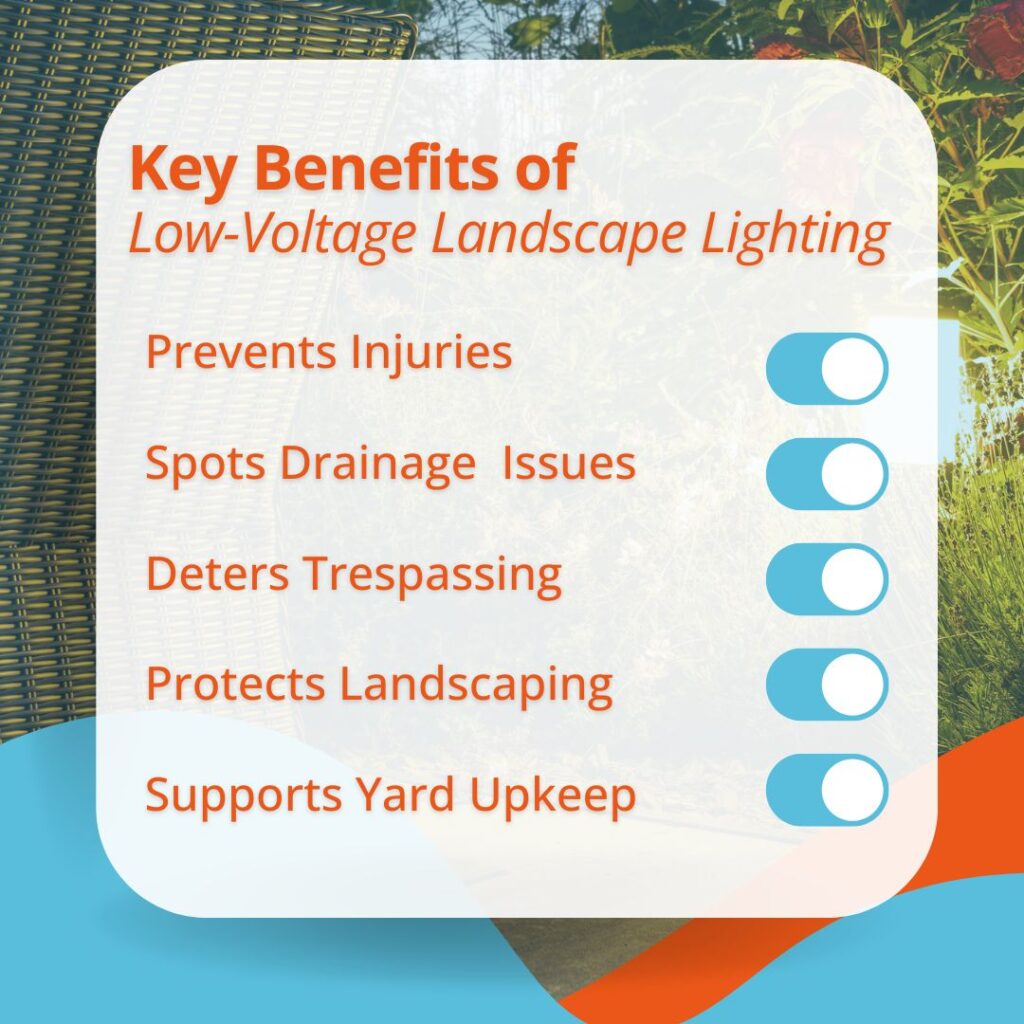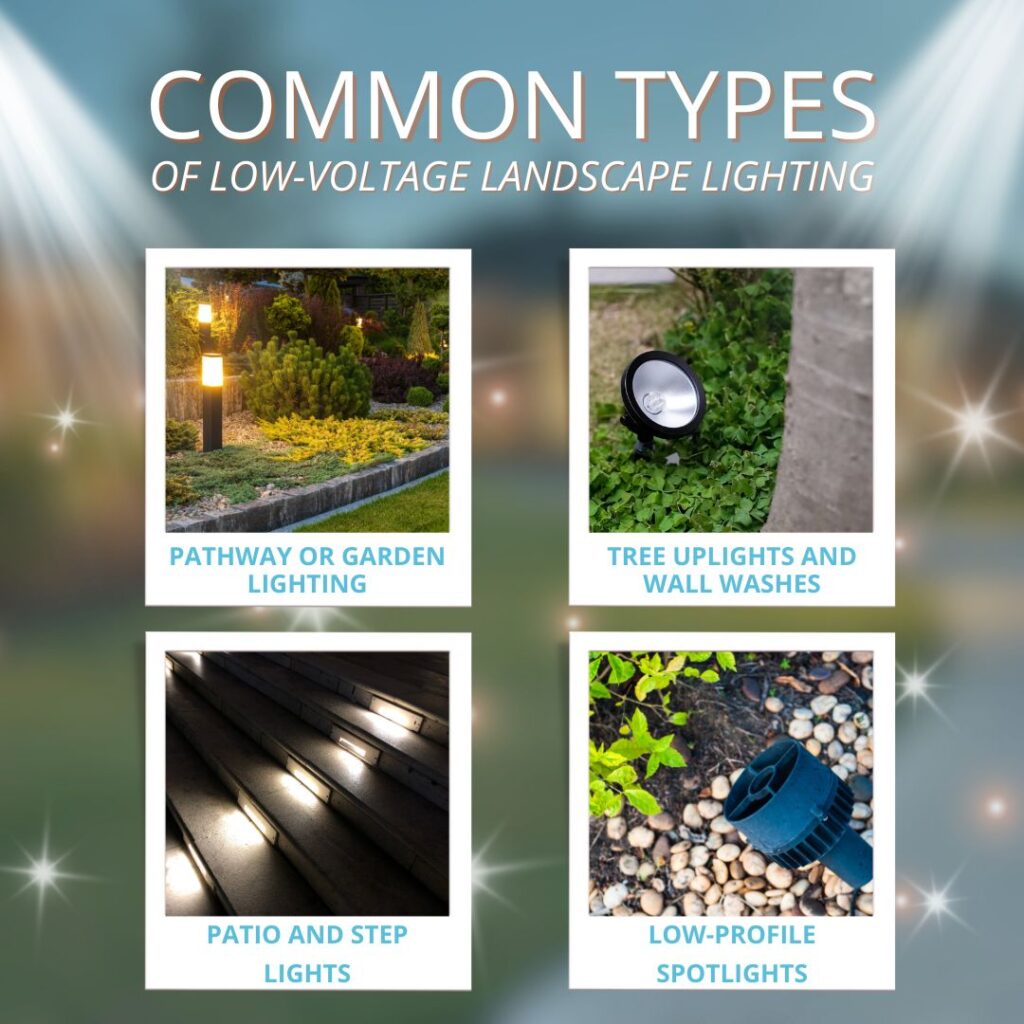This guide explains how low-voltage landscape lighting works, why it performs so well in Georgia’s climate, and how it can improve the look and feel of your entire property.
When the sun sets in Georgia, the yard changes. Shadows stretch across the lawn, trees fade into the background, and outdoor living spaces become harder to use. Many Georgia homeowners choose low voltage lighting as part of a larger outdoor improvement plan.
When lighting is paired with drainage updates, walkway repairs, or fresh landscaping, the entire yard functions better and looks more complete.
What Makes Low Voltage Lighting Different?
Low voltage lighting runs on a transformer that reduces power from standard household levels down to a safer, cooler, and more efficient current. Because of this, the lights use less energy and carry less risk around pets, plants, and high use areas.
The Department of Energy reports that LED fixtures can reduce energy use by up to 75% compared to older halogen systems.
Since Georgia homeowners often keep porch and path lights running for several hours each night, this matters for long term cost savings.
Low voltage systems also work better with the region’s humidity and heavy rain. Fixtures stay cooler, connections stay stable, and moisture is less likely to cause problems than it would with higher voltage outdoor wiring.

How Lighting Changes the Way You Use Your Yard
Instead of just placing a few lights along the walkway, a low voltage system supports every kind of outdoor living space. Georgia homes often have large trees, shaded corners, and long driveways, all of which benefit from the right lighting plan.
Brings Your Landscaping to Life at Night
Low voltage lighting highlights small details that disappear after sunset. Warm light on a crepe myrtle, oak, or magnolia creates depth and texture. A soft glow along a garden bed outlines shapes the same way sunlight does, just at a calmer level.
Instead of flooding the yard with brightness, these systems create layers. Some areas glow. Others stay low lit. The result feels natural and balanced, which is ideal for homes surrounded by greenery.
Extends Outdoor Living Hours
Georgia’s warm evenings make outdoor spaces just as valuable as indoor rooms. Low voltage lighting helps you use them longer without harsh glare.
It works well for:
• Back patios
• Fire pit areas
• Outdoor kitchens
• Screened porches
• Garden seating areas
• Pool and hot tub surroundings
Lights placed around the edges of a space make it feel welcoming without drawing bugs closer to the center. Because LED fixtures produce minimal heat, they attract fewer insects than older halogen bulbs.
Helps Guests Move Safely Through the Property
Visibility is one of the main reasons homeowners choose low voltage lighting. Mature landscaping creates deep shadows, and even a short path can become difficult to navigate after dark.
Soft lighting helps people see:
• Steps
• Walkway edges
• Grade changes
• Patio transitions
• Driveways
• Gate entrances
The National Safety Council notes that most outdoor trip accidents happen in low light conditions. Small, well placed fixtures make a difference without overwhelming the space with brightness.
The Design Impact You See Right Away
Low voltage lighting creates curb appeal that feels polished but not overdone. Because the fixtures run at a cooler temperature and use less power, designers can place them more creatively.
Lights Stay Soft Instead of Harsh
Many people avoid outdoor lighting because they picture bright spots that wash out the yard. Low voltage systems avoid this by using lower wattage LEDs that give off a clean, warm glow.
This suits Georgia homes well because:
• Trees often cast strong natural shadows
• Large porches benefit from gentle uplighting
• Brick and stone reflect soft light beautifully
• Yards with deep greens look richer under warm LEDs
The goal is not to turn the yard into a spotlight. It is to make it usable and attractive after dark.
Highlights Texture and Architecture
Soft uplighting along the base of a brick wall or stone column helps pull out texture that disappears at night. This adds depth and interest without any harsh glare.
Good placements include:
• Porch columns
• Stone walkways
• Raised garden beds
• Entry archways
• Retaining walls
• Water features
Even a single fixture placed thoughtfully can change the way an entire corner of the yard looks.
Balances Light Across the Space
A professional installation avoids bright hotspots. Instead, it carries light across the yard in a smooth, even way.
This helps:
• Reduce glare for drivers
• Keep neighbors comfortable
• Prevent harsh shadows near doors
• Maintain a natural look from the street
Balanced lighting is especially helpful for corner lots or long front lawns, which are common in Georgia neighborhoods.
Why It Performs Better in Georgia
The Southeast has long summers, mild winters, and periods of heavy rain. These conditions can wear out outdoor lighting systems that run hot or pull high power levels.
Low voltage lighting works better because:
• Fixtures stay cool, even in summer heat
• Wiring tolerates humidity better
• LED bulbs last longer in warm climates
• Lower voltage reduces risk in wet soil
The Department of Energy notes that LEDs last up to twenty five times longer than incandescent bulbs. In a region where porch and entry lights get year round use, this provides real value.
Humidity also plays a role. Warm nights bring moisture that clings to fixtures. Low voltage systems handle this better because the wiring and bulbs operate at safer, cooler temperatures.
Energy and Cost Benefits Over Time
While lighting is often thought of as a design choice, low voltage systems also offer strong long term value.
Lower Energy Use
LED path lights and uplights consume far less energy than halogen fixtures. Running a full low voltage system for several hours each night often costs less per month than a single older porch light bulb.
Smaller Transformers Save Power
Transformers in low voltage systems only pull the power needed to run the connected lights. This keeps monthly costs predictable and low.
Longer Bulb and Fixture Lifespan
Less heat means:
• Less wear on internal parts
• Fewer replacements
• Lower long term maintenance costs
This is ideal for Georgia homeowners who run outdoor lights almost every night of the year.

Yard Lighting Ideas That Work Well With Low Voltage
Lighting works even better when paired with certain landscape features. These project ideas boost the look and function of your yard.
Tree Uplighting for Mature Georgia Shade Trees
Homes with large oaks, pines, and magnolias look dramatic with uplighting. Even one or two well placed fixtures bring height and structure to the yard at night.
Walkway Lighting for Long Driveways
Many Georgia homes have extended driveways or curved paths. Low voltage fixtures help guide cars and guests safely to the home.
Water Feature Highlights
Small fountains, koi ponds, and waterfalls glow beautifully under soft lighting. LEDs make the water look clear and calm.
Garden Accent Lighting
Garden beds, retaining walls, and raised planters gain definition and depth at night. This works especially well with layered planting.
Related Questions
How does outdoor lighting affect home security?
Well placed lighting helps remove hiding spots around doors, windows, and side yards. This pairs naturally with security system installations and night visibility improvements.
Can lighting help with yard maintenance or drainage checks?
Lighting highlights low areas, standing water, and erosion patterns that are harder to see in daylight. This connects well to landscape grading and yard care content.
What yard upgrades work well with lighting projects?
Hardscape additions, walkway repairs, and garden redesigns benefit from lighting because it visibly outlines their structure at night.
How does lighting support outdoor living features?
Outdoor kitchens, decks, patios, and fire pits gain extra function with perimeter lighting. This fits well with outdoor room and entertainment space content.
When to Call a Professional
Homeowners often try solar stake lights first and then realize they want a more reliable option. A professional lighting installer helps with:
• Fixture placement
• Wiring layout
• Transformer sizing
• Waterproof connections
• Lighting balance across the yard
• Long term maintenance and support
Because Georgia properties vary in slope, trees, and layout, a custom plan ensures the lighting looks natural and performs well year round.
Conclusion
Low voltage landscape lighting changes the way you see and use your yard. It makes outdoor areas safer, highlights the best parts of your landscaping, and adds comfort to warm Georgia evenings. With lower energy use, long lasting fixtures, and flexible design options, it brings lasting value to any home.
If you’re planning a lighting upgrade or want a custom layout that fits your yard’s shape, trees, and walkways, a professional design makes all the difference. Rescue My Yard can help you choose the right fixtures, improve safety around the property, and create a lighting plan that looks good year round.
